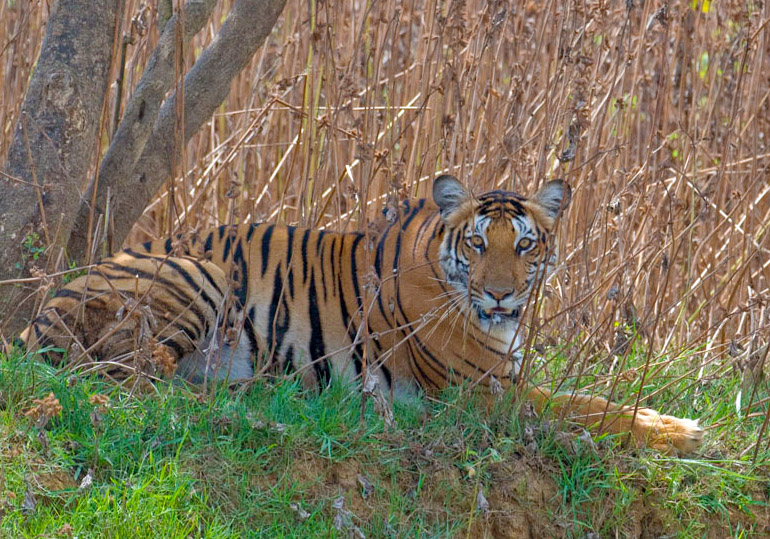
The shooting of tigress T1 – a.k.a. Avni – has raised a huge storm. On the one hand, animal rights activists have been agitating against the killing. On the other is the Forest Department, with the chief wildlife warden (CWLW) issuing a crucial order to hunt the tigress down after over a dozen people were killed.
Let’s analyse this controversy from the larger perspective of tiger conservation. There are three broad aspects: legal, ecological and management, that need to be examined.
First, most people may not know that the definition of hunting in the Wildlife (Protection) Act, 1972 includes both killing and capturing. The CWLW is empowered to permit hunting of any wild animal by an order in writing, after being satisfied that it poses a danger to human life. In Avni’s case, the CWLW’s also passed judicial scrutiny, with the Bombay High Court and the Supreme Court permitting the tranquilisation or shooting of T1.
The area where T1 was operating is highly fragmented, with multiple use forest patches honeycombed with villages. This is not a case of an inviolate core or critical tiger habitat being damaged, where people were intruding with cattle and disturbing the tigress, causing conflict.
Also read: The Killing of Avni the Tigress Leaves Blood on Maharashtra Government’s Hands
Tiger ecology tells us that tigers need large, protected habitats free from incompatible human uses, with buffer areas and corridors for dispersal. Scientific research has also established that tigers’ survival is linked to availability of sufficient prey, and that an adult tiger needs to make one deer-sized kill every week.
Sub-adult tigers start dispersing between 18 and 24 months of age, seeking to establish their own territory. Tigers are fecund animals and populations have dramatically increased in many reserves thanks to better protection. This leads to intense fights for space, with some tigers being pushed out to fringes. Such tigers could come into conflict with humans. And when conflict becomes severe – with repeated cases of man-eating – scientific opinion is very clear: the tiger must be identified quickly and captured or even killed as a last resort.
But identifying the “guilty” animal is no easy task. In the mid-1990, there was a serious case of man-eating leopards in Karnataka and 11 people were killed. Seventeen leopards had to be shot before the man-eating stopped. Even though this will shock many people, it may be the only pragmatic option to resolve persistent man-eating.
Scientists who have studied tigers for decades, and conservationists are of the firm view that capturing or killing problem animals is absolutely essential in the larger interest of saving the species. It is at this point that animal rights activism and ecology part ways.
Many have asked why T1 was not tranquilised. The simple answer: tranquilisation was tried but did not succeed. Unlike a bullet, which can pierce through vegetation, a tranquiliser dart is vulnerable to a number of factors. To be effective, the dart has to hit a muscular portion of the tiger, like the shoulder or the upper hind leg. Achieving an accurate shot through thick undergrowth like lantana is not easy. Even heavy wind can deflect a dart from its flight path.
Moreover, a tranquilised man-eater cannot be released in another forest because it will unleash a new reign of terror on unsuspecting local people. It may also come into conflict with other territorial tigers in the area. So the captured man-eater can only be shunted to a life in captivity, where it suffers enormous stress until it finally dies.
Notwithstanding this, a thorough, independent inquiry must be ordered after every shooting incident to determine whether the Standard Operating Procedures and/or conditions cited in the order of the CWLW were violated. If so, action as per law must be initiated.
Finally, from a wildlife management perspective, it is of vital importance to resolve such severe conflicts decisively to ensure that public support for conservation is not lost. When such action is not taken, the first and most vulnerable targets are frontline forest staff who have to face the ire of the mob.
Forest infrastructure like vehicles, check posts and camps are often vandalised. Local forest mafias use such public anger to settle scores by targeting forest officials with assault. In extreme situations, as in the recent conflict Dudhwa, infuriated mobs may even enter national parks, overrun forest posts and kill other ‘innocent’ tigers or set fire to forests.
Also read: Chronicling the Killing of T1, the Tigress
Therefore, the CWLWs must be allowed to act decisively whenever warranted based on expert advice. Well-meaning but ill-informed and emotion-driven urban activists – divorced from reality or responsibility – do not help the cause of tiger conservation when they make impractical demands on wildlife managers.
The one big mistake happening in several states is that private hunters are being hired. Maneka Gandhi, the Union minister for women and child development and a passionate animal rights crusader, was absolutely right when she raised this issue with Avni’s killing. She must ensure that the environment ministry and the National Tiger Conservation Authority take a policy decision to not requisition such private hunters. Instead, they must be directed to develop internal capacities by training hand-picked foresters as sharp-shooters or enlist sharp-shooters from elite police commando units or from among recently retired army snipers.
This is certainly not the last incident of such grave human-wildlife conflict that we will witness. It is therefore time that the forest departments equip and train special units in wildlife capture, rescue and elimination.
Further, animal rights activists must accept that in order to achieve the larger goal of saving tigers in the wild, the loss of a few individual animals is unavoidable when human lives and public order are at stake.
Praveen Bhargav has served on the National Board for Wildlife and on expert committees of the National Tiger Conservation Authority.

